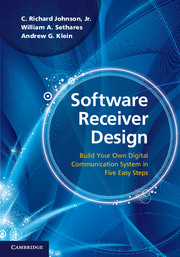To the Instructor …
Published online by Cambridge University Press: 05 June 2012
Summary
… though it's OK for the student to listen in.
Software Receiver Design helps the reader build a complete digital radio that includes each part of a typical digital communication system. Chapter by chapter, the reader creates a Matlab® realization of the various pieces of the system, exploring the key ideas along the way. In the final chapters, the reader “puts it all together” to build fully functional receivers, though as Matlab code they are not intended to operate in real time. Software Receiver Design explores telecommunication systems from a very particular point of view: the construction of a workable receiver. This viewpoint provides a sense of continuity to the study of communication systems.
The three basic tasks in the creation of a working digital radio are
1. building the pieces,
2. assessing the performance of the pieces,
3. integrating the pieces.
In order to accomplish this in a single semester, we have had to strip away some topics that are commonly covered in an introductory course and emphasize some topics that are often covered only superficially. We have chosen not to present an encyclopedic catalog of every method that can be used to implement each function of the receiver. For example, we focus on frequency division multiplexing rather than time or code division methods, and we concentrate only on pulse amplitude modulation and quadrature amplitude modulation.
- Type
- Chapter
- Information
- Software Receiver DesignBuild your Own Digital Communication System in Five Easy Steps, pp. v - viiiPublisher: Cambridge University PressPrint publication year: 2011



